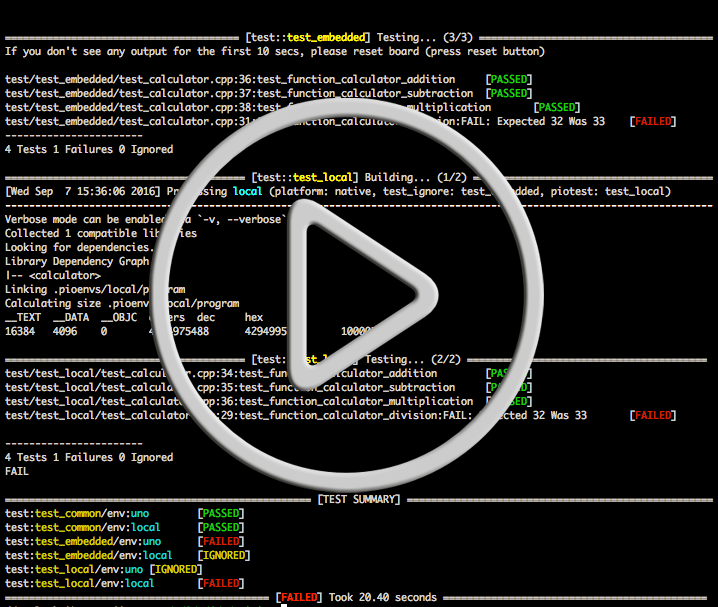PIO Unit Testing¶
New in version 3.0: (PIO Plus)
Unit Testing (wiki) is a software testing method by which individual units of source code, sets of one or more MCU program modules together with associated control data, usage procedures, and operating procedures, are tested to determine whether they are fit for use. Unit testing finds problems early in the development cycle.
Demo¶
Demo of Local & Embedded: Calculator.

Tutorials and Examples¶
Tutorials¶
Project Examples¶
For the other examples and source code please follow to PlatformIO Unit Testing Examples repository.
Configuration¶
PIO Unit Testing Engine can be configured from “platformio.ini” (Project Configuration File)
Test Types¶
Desktop¶
PIO Unit Testing Engine builds a test program for a host machine using Native development platform. This test could be run only with the desktop or Continuous Integration VM instance.
Note
PlatformIO does not install any toolchains automatically for
Native and requires GCC toolchain to be installed
on your host machine.
Please open Terminal and check that the gcc command is installed.
Embedded¶
PIO Unit Testing Engine builds a special firmware for a target device (board) and program it. Then, it connects to this device using configured Serial test_port and communicate via test_transport. Finally, it runs test on an embedded side, collects results, analyzes them and provides a summary on a host machine side (desktop).
Note
Please note that the PIO Unit Testing Engine uses the first available Serial/UART
implementation (depending on a framework) as a
communication interface between the PIO Unit Testing Engine and target device. If you use
Serial in your project libraries, please wrap/hide Serial-based blocks
with #ifndef UNIT_TEST macro.
Also, you can create custom test_transport and implement base interface.
Test Runner¶
Test Runner allows you to process specific environments or ignore a test using “Glob patterns”. You can also ignore a test for specific environments using a test_ignore option from “platformio.ini” (Project Configuration File).
Local¶
Allows you to run a test on a host machine or on a target device (board) which is directly connected to the host machine. In this case, you need to use the platformio test command.
Remote¶
Allows you to run test on a remote machine or remote target device (board) without having to depend on OS software, extra software, SSH, VPN or opening network ports. Remote Unit Testing works in pair with PIO Remote. In this case, you need to use the special command platformio remote test.
PlatformIO supports multiple Continuous Integration systems where you can run unit tests at the each integration stage. See real PlatformIO Remote Unit Testing Example.
Workflow¶
Create PlatformIO project using the platformio init command. For Desktop Unit Testing (on a host machine), you need to use Native.
; PlatformIO Project Configuration File ; ; Build options: build flags, source filter, extra scripting ; Upload options: custom port, speed and extra flags ; Library options: dependencies, extra library storages ; ; Please visit documentation for the other options and examples ; https://docs.platformio.org/page/projectconf.html ; ; Embedded platforms ; [env:uno] platform = atmelavr framework = arduino board = uno [env:nodemcu] platform = espressif8266 framework = arduino board = nodemcuv2 ; ; Desktop platforms (Win, Mac, Linux, Raspberry Pi, etc) ; See https://platformio.org/platforms/native ; [env:native] platform = native
Create a
testfolder in a root of your project. See test_dir.Write a test using API. Each test is a small independent program/firmware with its own
main()orsetup()/loop()functions. Test should start withUNITY_BEGIN()and finish withUNITY_END()calls.Warning
If your board does not support software reseting via
Serial.DTR/RTS, you should add >2 seconds delay beforeUNITY_BEGIN()`. That time is needed to establish a ``Serialconnection between a host machine and a target device.delay(2000); // for Arduino framework wait(2); // for ARM mbed framework UNITY_BEGIN();
Place a test in the
testdirectory. If you have more than one test, split them into sub-folders. For example,test/test_1/*.[c,cpp,h],test_N/*.[c,cpp,h], etc. If there is no such directory in thetest``folder, then |PIOUTE| will treat the source code of ``testfolder as SINGLE test.Run test using the platformio test command.
API¶
Summary of the Unity Test API:
-
RUN_TEST(func, linenum)
-
TEST_IGNORE()TEST_IGNORE_MESSAGE (message)
-
TEST_PROTECT()TEST_ABORT()
-
TEST_ASSERT_TRUE(condition)TEST_ASSERT_FALSE(condition)TEST_ASSERT(condition)TEST_ASSERT_UNLESS(condition)TEST_FAIL()TEST_FAIL_MESSAGE(message)
Numerical Assertions: Integers
TEST_ASSERT_EQUAL_INT(expected, actual)TEST_ASSERT_EQUAL_INT8(expected, actual)TEST_ASSERT_EQUAL_INT16(expected, actual)TEST_ASSERT_EQUAL_INT32(expected, actual)TEST_ASSERT_EQUAL_INT64(expected, actual)TEST_ASSERT_EQUAL_UINT(expected, actual)TEST_ASSERT_EQUAL_UINT8(expected, actual)TEST_ASSERT_EQUAL_UINT16(expected, actual)TEST_ASSERT_EQUAL_UINT32(expected, actual)TEST_ASSERT_EQUAL_UINT64(expected, actual)TEST_ASSERT_EQUAL_HEX(expected, actual)TEST_ASSERT_EQUAL_HEX8(expected, actual)TEST_ASSERT_EQUAL_HEX16(expected, actual)TEST_ASSERT_EQUAL_HEX32(expected, actual)TEST_ASSERT_EQUAL_HEX64(expected, actual)TEST_ASSERT_EQUAL_HEX8_ARRAY(expected, actual, elements)TEST_ASSERT_EQUAL(expected, actual)TEST_ASSERT_INT_WITHIN(delta, expected, actual)
-
TEST_ASSERT_BITS(mask, expected, actual)TEST_ASSERT_BITS_HIGH(mask, actual)TEST_ASSERT_BITS_LOW(mask, actual)TEST_ASSERT_BIT_HIGH(mask, actual)TEST_ASSERT_BIT_LOW(mask, actual)
-
TEST_ASSERT_FLOAT_WITHIN(delta, expected, actual)TEST_ASSERT_EQUAL_FLOAT(expected, actual)TEST_ASSERT_EQUAL_DOUBLE(expected, actual)
-
TEST_ASSERT_EQUAL_STRING(expected, actual)TEST_ASSERT_EQUAL_STRING_LEN(expected, actual, len)TEST_ASSERT_EQUAL_STRING_MESSAGE(expected, actual, message)TEST_ASSERT_EQUAL_STRING_LEN_MESSAGE(expected, actual, len, message)
-
TEST_ASSERT_NULL(pointer)TEST_ASSERT_NOT_NULL(pointer)
-
TEST_ASSERT_EQUAL_MEMORY(expected, actual, len)